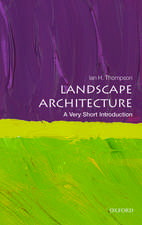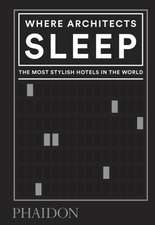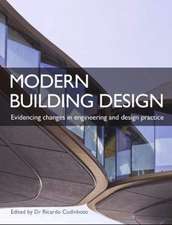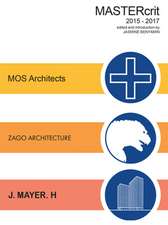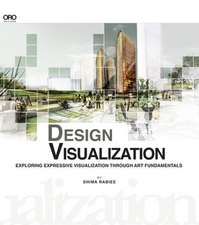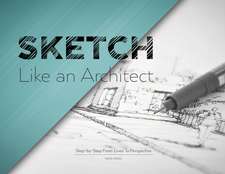How Designers Think
Autor Bryan Lawsonen Limba Engleză Paperback – 14 oct 2005
In this fourth edition, Bryan Lawson continues to try and understand how designers think, to explore how they might be better educated and to develop techniques to assist them in their task. Some chapters have been revised and three completely new chapters added. The book is now intended to be read in conjunction with What Designers Know which is a companion volume. Some of the ideas previously discussed in the third edition of How Designers Think are now explored more thoroughly in What Designers Know. For the first time this fourth edition works towards a model of designing and the skills that collectively constitute the design process.
Preț: 373.15 lei
Nou
Puncte Express: 560
Preț estimativ în valută:
71.40€ • 76.35$ • 59.53£
71.40€ • 76.35$ • 59.53£
Carte disponibilă
Livrare economică 27 martie-10 aprilie
Livrare express 12-18 martie pentru 37.92 lei
Preluare comenzi: 021 569.72.76
Specificații
ISBN-13: 9780750660778
ISBN-10: 0750660775
Pagini: 334
Ilustrații: 1, black & white illustrations
Dimensiuni: 189 x 246 x 20 mm
Greutate: 0.59 kg
Ediția:Revizuită
Editura: Taylor & Francis
Colecția Routledge
Locul publicării:Oxford, United Kingdom
ISBN-10: 0750660775
Pagini: 334
Ilustrații: 1, black & white illustrations
Dimensiuni: 189 x 246 x 20 mm
Greutate: 0.59 kg
Ediția:Revizuită
Editura: Taylor & Francis
Colecția Routledge
Locul publicării:Oxford, United Kingdom
Public țintă
Professional Practice & DevelopmentCuprins
Part 1 What Is Design?; Chapter 1 Introduction; Chapter 2 The Changing Role of the Designer; Chapter 3 Route Maps of the Design Process; Part 2 Problems and Solutions; Chapter 4 The Components of Design Problems; Chapter 5 Measurement, Criteria and Judgement in Design; Chapter 6 A Model of Design Problems; Chapter 7 Problems, Solutions and the Design Process; Part 3 Design Thinking; Chapter 8 Types and Styles of Thinking; Chapter 9 Creative Thinking; Chapter 10 Guiding Principles; Chapter 11 Design Strategies; Chapter 12 Design Tactics; Chapter 13 Design Traps; Chapter 14 Designing with Others; Chapter 15 Design as Conversation and Perception; Chapter 16 Towards a Model of Designing;
Recenzii
'An extremely readable book, due in part to the soundbite-sized chapters'
Architects Journal, 19.01.06
"There is no set path to beautiful design, and as designers we are always moving forward, looking for the next problem to solve. Lawson reminds us, however, that taking the time to engage the issues comprehensively leads to more well-rounded, and ultimately better finished products. As such, developing a solid set of foundation skills and methods are of the utmost importance, permeating into other work and yielding stronger results." — Jeremy Senko, Spacing Magazine
Reviews of previous editions:
'It has a great virtue of being thorough and readable... excellent bibliography.'
Built Environment
'This book makes a valuable, if individualistic contribution to the literature of design theory.'
Science and Technology Press
'The author succeeds in demystifying his subject for the lay reader.'
New Scientist
'The chapters are well written in a readable form and packed full of data undeniably valuable to students.'
ASI Journal
'Its success is well deserved, because it is clearly written, the arguments are logically presented, and the design process is indeed demystified.'
Architectural Science Review
Architects Journal, 19.01.06
"There is no set path to beautiful design, and as designers we are always moving forward, looking for the next problem to solve. Lawson reminds us, however, that taking the time to engage the issues comprehensively leads to more well-rounded, and ultimately better finished products. As such, developing a solid set of foundation skills and methods are of the utmost importance, permeating into other work and yielding stronger results." — Jeremy Senko, Spacing Magazine
Reviews of previous editions:
'It has a great virtue of being thorough and readable... excellent bibliography.'
Built Environment
'This book makes a valuable, if individualistic contribution to the literature of design theory.'
Science and Technology Press
'The author succeeds in demystifying his subject for the lay reader.'
New Scientist
'The chapters are well written in a readable form and packed full of data undeniably valuable to students.'
ASI Journal
'Its success is well deserved, because it is clearly written, the arguments are logically presented, and the design process is indeed demystified.'
Architectural Science Review
Descriere
How Designers Think is based on Bryan Lawson's many observations of designers at work, interviews with designers and their clients and collaborators. This extended work is the culmination of forty years' research and shows the belief that we all can, and do, design, and that we can learn to design better. The creative mind continues to have the power to surprise and this book aims to nurture and extend this creativity. Neither the earlier editions, nor this book, are intended as authoritative prescriptions of how designers should think but provide helpful advice on how to develop an understanding of design.
In this fourth edition, Bryan Lawson continues to try and understand how designers think, to explore how they might be better educated and to develop techniques to assist them in their task with new and revised chapters.
In this fourth edition, Bryan Lawson continues to try and understand how designers think, to explore how they might be better educated and to develop techniques to assist them in their task with new and revised chapters.

